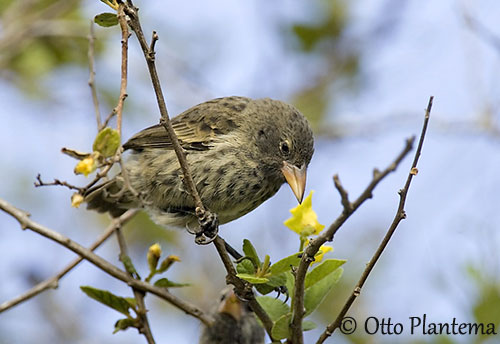
Fr: Géospize pique-bois
All: Spechtdarwinfink
Esp: Pinzón de Darwin Carpintero, Pinzón artesano
Ital: Fringuello picchio
Nd: Spechtvink
Sd: Spettfink
Photographers:
John Anderson
John Anderson Photo Galleries
Otto Plantema
Trips around the world
Text by Nicole Bouglouan
Sources:
HANDBOOK OF THE BIRDS OF THE WORLD Vol 16 by Josep del Hoyo- Andrew Elliot-David Christie – Lynx Edicions – ISBN: 9788496553781
L’ENCYCLOPEDIE MONDIALE DES OISEAUX - Dr Christopher M. Perrins - BORDAS - ISBN: 2040185607
BirdLife International (BirdLife International)
Wikipedia, the free encyclopaedia
Woodpecker Finch
Camarhynchus pallidus
Passeriforme Order – Thraupiade Family
Darwin’s Finches - Generalities
INTRODUCTION:
The Woodpecker Finch is an ingenious bird which uses tools to get its food. It holds a twig, a short-hard stick or a cactus spine with the bill, in order to extract preys from bark crevices. This bird is able to drill holes in trees like woodpeckers, giving the species its name. It is endemic to Galapagos Islands.
DESCRIPTION OF THE BIRD:
Biometrics:
Length: 15 cm
Weight: 20-31 g
The adult male has unstreaked pale sandy-brown upperparts, upperwing and short tail. We can see two narrow, indistinct, pale cinnamon wingbars.
The underparts are buffish-white. According to the birds, some individuals are unstreaked, while others show weak, greyish streaks on breast, darker on the sides, and fading on belly and flanks.
On the head, the face is pale sandy-brown. We can see a whitish area on lores and around the eye.
The bill is long, with arched culmen and nearly straight gonys. It is black during the breeding season, and with paler lower mandible outside this period. The eyes are dark brown. Legs and feet are blackish-grey.
The female resembles male but she has buff wash on her plumage. Her bill is dull orange, often with darker culmen and tip. It does not become black during the breeding season.
The juvenile is similar to female.

SUBSPECIES AND RANGE:
We can find three subspecies which differ in size and plumage.
C.p. productus is found on Fernandina and Isabela, in W Galapagos Islands. This one is smaller than nominate, with shorter bill. Its plumage is darker and usually more streaked below.
C.p. pallidus (here described) occurs on Santiago, Rábida, Pinzón, Baltra, Santa Cruz and Floreana, in C and S Galapagos Islands.
C.p. striatipecta is found on San Cristobal in SE Galapagos Islands. It is also smaller than nominate and with shorter bill. It has strongly streaked breast and flanks, and weak streaks on the upperparts.
HABITAT:
The Woodpecker Finch frequents various habitats and can be seen at different elevations in the evergreen forest in mountains. It is usually fairly common in transitions areas, but also farther up humid forest zone.
CALLS AND SONGS: SOUNDS BY XENO-CANTO
The Woodpecker Finch utters loud, far-carrying sounds, usually a sharp, descending whistle near the nest, and the territorial song includes 7-8 loud, rapid notes “chup-tupupupu chup-tupupupu”, or “cht-trrr cht-trrr”, and “chik-tip-tip-tip-tip chik-tip-tip-tip-tip”, often more warbled than those of other Darwin’s Finches. The call is a nasal “pheew”.
BEHAVIOUR IN THE WILD:
The Woodpecker Finch feeds on arthropods, including wood-boring beetle larvae (coleopteran). It forages by crawling along branches or by clinging to tree trunks. It pecks at branches like a woodpecker (Picidae) in order to get preys from inside the wood.
But the Woodpecker Finch is one of the some species which use a tool for extracting its food from bark crevices. It chooses a short-pointed stick or cactus needles, and by holding this tool with the bill, it can reach the concealed insect preys. It can be seen creeping along branches where it probes in bark or in dry leave’s clumps, thanks to its long, pointed bill.

This species usually occurs alone or in pairs. They are socially monogamous, and can be territorial during the breeding season. The pair maintains a small territory where the nest is built.
They breed mainly during the rainy season when food sources are abundant.
The Woodpecker Finch is resident in its restricted range, and only performs short flights.
REPRODUCTION OF THIS SPECIES:
The Woodpecker Finch male builds the nest, a sphere with side entrance towards the top. It uses dry grasses, moss and lichens, and other available vegetation.
The female lays 4 whitish eggs with darker markings. She incubates during 12-13 days. The chicks fledge about two weeks after hatching.
PROTECTION / THREATS / STATUS:
The Woodpecker Finch can be locally common and widespread in its restricted range. This species is threatened by destruction of the habitat, introduced species and diseases, but currently, populations appear stable and the Woodpecker Finch is not currently threatened.